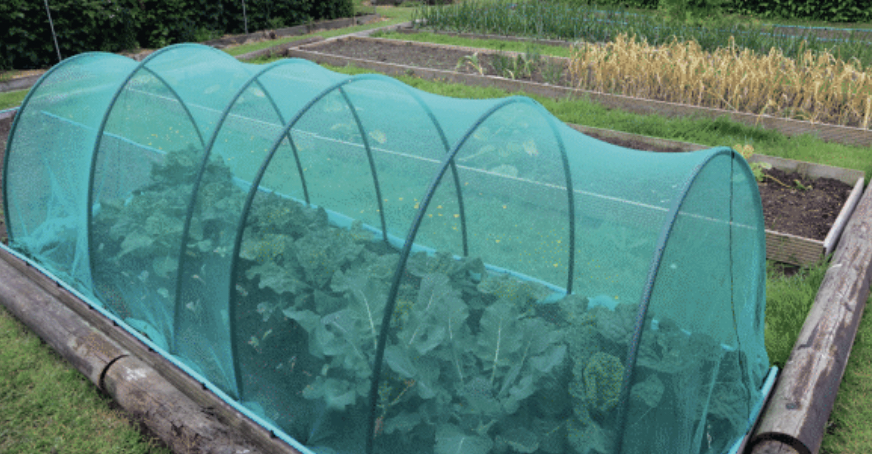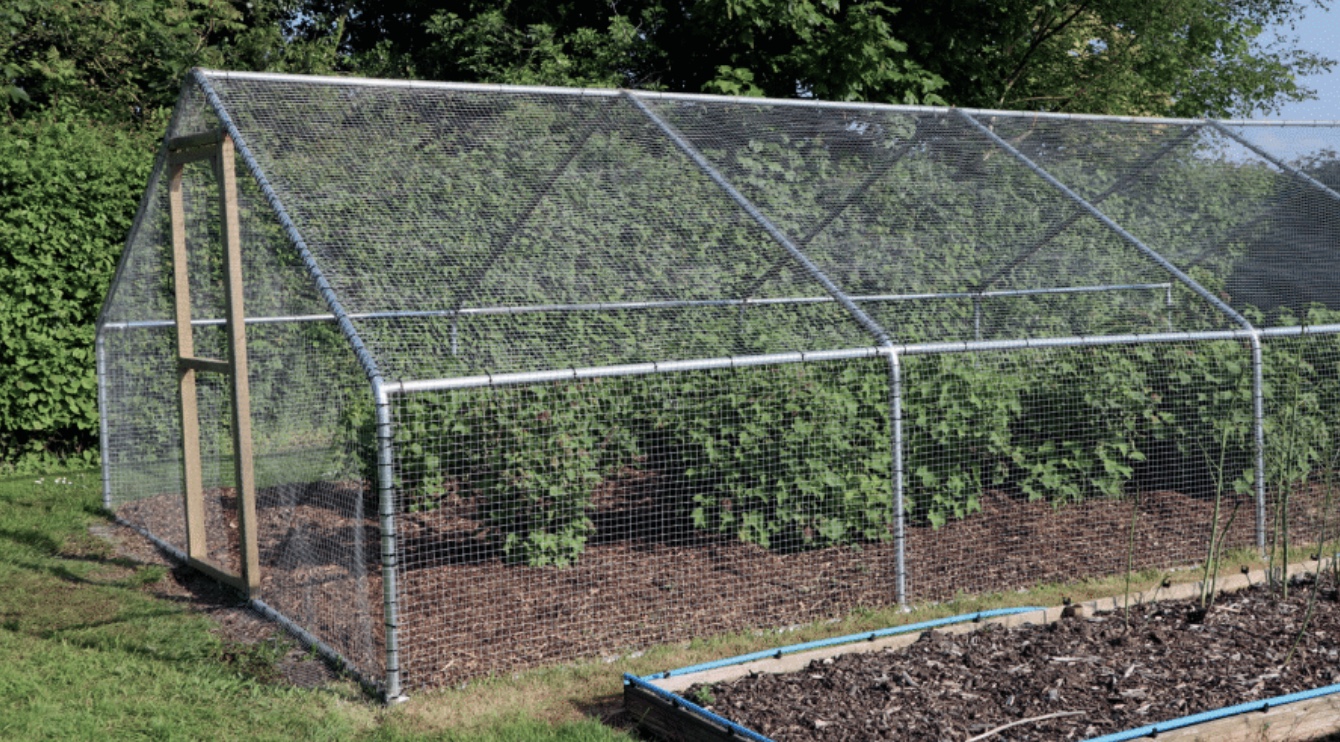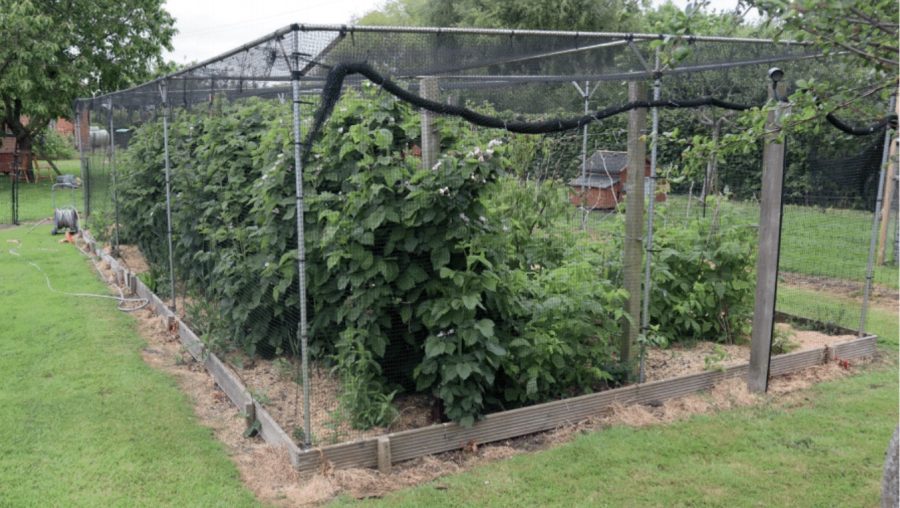English Country Life‘s Fiona and Hugh Osborne explain how to use fruit and vegetable cages to protect valuable crops from rodents, birds and insects.
As soon as we started growing significant quantities of fruit and vegetables, we found that lots of other creatures liked them too! We lost entire crops of cabbages to caterpillars, berries to birds and even strawberries to mice and voles.
Whilst we found it possible to pick off occasional caterpillars, the more crops we grew, the harder that job became. Running around waving our arms at birds eating our blackcurrants wasn’t effective for even a small number of bushes and canes. As we expanded our activities, we realised that we needed to take action as our losses were unsustainable. We did talk to farmer friends as to what they used. At the time insecticides were widespread in protecting brassicas.
Whilst that seemed an easy solution, we were slightly alarmed about the warning on some long-lasting treatments such as “If you use this stuff, you must plant out using gloves as it’s dangerous if you get it on your skin”. The idea of not touching the food that we intend to eat later because of the toxicity of the treatment just wasn’t for us so we decided to look for other solutions. Ultimately, we settled on physical barriers in the form of fruit and vegetable cages.
ROW COVERS
Our first experiments in crop protection followed the approaches common to most gardeners and allotmenteers, net supported on hoops to cover annual crops of cabbages, cauliflowers and over young lettuces and peas to keep the dratted wood pigeons off! These systems work well and have the great advantage of being cheap, simple to install and easy to move from place to place. We did find quickly that the choice of a supporting frame made a huge difference to the longevity of our covers and cages. Wood tended to rot. Stiff fence wire worked well for short term row covers on young peas, lettuces etc. and would easily thrust into the soil. On longer term installations though the wire would tend to rust, and it was often not sufficiently strong for taller covers for Brussel sprouts and the wire bent in the wind (or when pigeons landed on it).
An allotments owner and plumber showed us their solution – MDPE pipe! This is the stuff often found as blue water pipe and in various other guises. He was able to source offcuts from building projects and cut them to three metre lengths that made brilliant supports for netting. He got some for us that is now over 15 years old and looks like new, it’s brilliant stuff and often available for free from friendly plumbers or (with permission) from skips. It’s even not too expensive if you have to actually buy a roll. The same chap clued us into a great source of insect netting, green “debris net” often used on building sites. This is a very fine mesh, more than fine enough to keep out butterflies and other harmful insects. It comes in 3m wide rolls which is wide enough to cover a four foot wide vegetable bed to a good height. It partners well with the MDPE pipe in that there are often lengths left over after building projects and a polite request accompanied by a home-made cake will often secure generous amounts from friendly builders.

MDPE pipe offcuts make long lasting cover supports
Once we started using vegetable covers, we found that having standardised vegetable beds made life much easier. The same lengths of pipe fit every spot as we rotate crops and succession plant – we can’t tell you how important that is. The nets are always the right length and we keep a bucket of metal tent pegs to peg down the bottom.
BUT we found that as easy as it is to just thrust pipes into the ground, throw a cover over and peg it down, it didn’t make for easy, regular access. Where we tried to use this technique on our strawberry beds, we found access a problem. During harvest season, we needed to get into the strawberry beds several times a week to pick the ripening fruit and, whereas taking a cover off once to harvest a few caulis was fine, unpegging the whole arrangement every other day was a major grind!
Much head scratching and planning followed, and we consulted the John Seymour book “The Self-Sufficient Gardener” (sadly out of print now but you can find it second hand). In the book he describes complete moveable frames. This wasn’t quite right for us, but we figured out that we could build a moveable attachment to our raised beds where the bottom of each net would be attached to more MDPE pipe that simply clipped to saddle clips attached to the frame of the raised bed.
To open this frame, all we had to do was grasp the bottom of the net and pull so it would unclip. We used debris netting for full bed insect covers or wider bird mesh for strawberries – this would allow insects in but keep birds off the fruit.
FRUIT CAGES
Our row covers and fruit covers worked well for veg and even strawberries but proved wholly unsuitable for larger types of fruit. Things like berries that needed wire supports and currants were just too large for the sort of structures we were making. We bit the bullet and bought a commercial walk-in fruit cage. We decided on an aluminium frame. We live in the fens of Lincolnshire and wet conditions mean corrosion, so aluminium made sense as a rust-free option.
We bought all the optional extra reinforcements like footplates, corner reinforcements etc. and these did bump the price up considerably but given that the winds here are ferocious we thought it made sense. We laid out the plot in the middle of Winter as it was a “quiet time”.
Don’t be like us, please consider the joy of digging in manure onto snow covered frozen ground. It was an exercise in foolish naivety that no experienced person would make! The fruit cage we ended up with does work, but it isn’t without its problems. The aluminium frame although light and corrosion resistant isn’t very strong.
This means that if the roof accumulates snow or ice in Winter the whole structure could collapse.This isn’t a vague warning, it happened to some of our nearest neighbours! So, every Winter we have to take off the roof. It’s designed to be removable, and the manufacturer does suggest taking it off, but honestly the process of taking it off and putting it back on again in. Spring is really awkward and it’s a job that we both dread.
Another problem that we found is the plastic mesh supplied for the sides. It has lasted well but it’s not terribly strong which has caused us problems. The first is that rodents can, and do, chew through the “walls”. Once a hole is made, rabbits and larger critters enlarge it. Then birds also get in. We regularly have to patch over holes.
The second problem is the strimmer just cuts through the plastic walls. This problem is bad enough that we have fitted a 6” board around the base. In all fairness, the commercial fruit cage does work, we just didn’t realise that it would be quite so fragile.
This year we wanted to replace a temporary fruit cage we had built over our currants. We discussed our experiences with our previous fruit cage and decided we really didn’t want another one like that. We were looking at steel framed fruit cages (but they still had plastic mesh and were very expensive) when inspiration struck. We have a walk-in run for our broody hens. It’s incredibly (even ridiculously) strong, made from hot dipped galvanised steel tubing 38mmin diameter. You can do chin-ups on it! We had also opted to upgrade from the normal hex wire to 19-gauge weld mesh. A rodent would need wire cutters to get into it.

Chicken run fruit cage
We’d got our chicken run from Garden Life Direct – a local Lincolnshire firm – and they had been great. We emailed them and asked if they made fruit cages. It turned out that they didn’t, but given their walk-in runs come in a whole variety of widths, heights, lengths, and wire options, we wondered was there any reason that we couldn’t use one as a fruit cage?
“None at all” they replied, so we opted for an 8mx 4m walk in run with 1” weld mesh that we think will allow pollinating insects in but keep birds from stealing our currants. Having built the fruit cage, it’s every bit as robust as we thought it would be. The pitched roof will make it more snow resistant and much easier to sweep off any build up without removing the roof each Winter. The poles are like galvanised scaffolding and the wire mesh is super strong. There’s a half inch weld mesh option too. We are so delighted with it that we plan to build a permanent Winter chicken enclosure from Garden Life Direct, a massive 18m long structure.
WHAT ABOUT THE TREES ?
One thing we have yet to find a solution for is cherry trees. Hugh in particular absolutely adores cherries and planted several cherry trees in our orchard, but the birds love them too. Having a number of trees does mean that we do get a crop, but we have to watch them (like hawks) or the blackbirds and pigeons get them before we do. We’ve tried netting branches (tricky and they grow through the mesh) and even whole trees (a crazy operation involving scaffolding and never to be repeated). A small-scale solution to protecting cherries would be awesome. If you know of one, do please let us know!
Watch our currant cage video here.
This article originally appeared, in full, in the August 2023 edition of The Country Smallholder magazine.
To receive regular copies of The Country Smallholder magazine featuring more articles like this, subscribe here.
For FREE updates from the world of smallholding, sign up for The Country Smallholder newsletter here.








